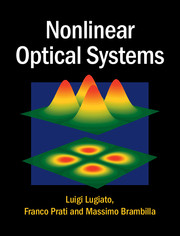Book contents
- Frontmatter
- Dedication
- Contents
- Preface
- Part I Models, propagation, stationary phenomena
- 1 The rate-equation model for the laser
- 2 The interaction of a system of two-level atoms with the electromagnetic field
- 3 The Maxwell–Bloch equations
- 4 Inclusion of the irreversible processes in the atomic equations
- 5 Propagation in irreversible Maxwell–Bloch equations
- 6 Optical nonlinearities. Materials with quadratic nonlinearities
- 7 Optical nonlinearities. Materials with cubic nonlinearities
- 8 Optical resonators. The planar ring cavity. Empty cavity. Linear cavity
- 9 A nonlinear active ring cavity: the ring laser, stationary states
- 10 The adiabatic elimination principle
- 11 A nonlinear passive ring cavity: optical bistability
- 12 Modal equations for the ring cavity. The single-mode model
- 13 Single- and two-mode models
- 14 Nonlinear dynamics in Fabry–Perot cavities
- 15 Inhomogeneous broadening
- 16 The semiconductor laser
- 17 Lasers without inversion and the effects of atomic coherence
- Part II Dynamical Phenomena, Instabilities, Chaos
- Part III Transverse optical patterns
- Appendix A The Routh–Hurwitz stability criterion
- Appendix B Calculation of the oscillatory instability boundary
- Appendix C Coefficients of the characteristic equation (20.20)
- Appendix D Derivation of equations (20.27) and (20.28)
- Appendix E Coefficients of equations (20.60) and (20.61)
- Appendix F The exact boundary of the Risken–Nummedal–Graham–Haken instability
- Appendix G Nonlinear analysis of the roll solution
- References
- Index
13 - Single- and two-mode models
from Part I - Models, propagation, stationary phenomena
Published online by Cambridge University Press: 05 March 2015
- Frontmatter
- Dedication
- Contents
- Preface
- Part I Models, propagation, stationary phenomena
- 1 The rate-equation model for the laser
- 2 The interaction of a system of two-level atoms with the electromagnetic field
- 3 The Maxwell–Bloch equations
- 4 Inclusion of the irreversible processes in the atomic equations
- 5 Propagation in irreversible Maxwell–Bloch equations
- 6 Optical nonlinearities. Materials with quadratic nonlinearities
- 7 Optical nonlinearities. Materials with cubic nonlinearities
- 8 Optical resonators. The planar ring cavity. Empty cavity. Linear cavity
- 9 A nonlinear active ring cavity: the ring laser, stationary states
- 10 The adiabatic elimination principle
- 11 A nonlinear passive ring cavity: optical bistability
- 12 Modal equations for the ring cavity. The single-mode model
- 13 Single- and two-mode models
- 14 Nonlinear dynamics in Fabry–Perot cavities
- 15 Inhomogeneous broadening
- 16 The semiconductor laser
- 17 Lasers without inversion and the effects of atomic coherence
- Part II Dynamical Phenomena, Instabilities, Chaos
- Part III Transverse optical patterns
- Appendix A The Routh–Hurwitz stability criterion
- Appendix B Calculation of the oscillatory instability boundary
- Appendix C Coefficients of the characteristic equation (20.20)
- Appendix D Derivation of equations (20.27) and (20.28)
- Appendix E Coefficients of equations (20.60) and (20.61)
- Appendix F The exact boundary of the Risken–Nummedal–Graham–Haken instability
- Appendix G Nonlinear analysis of the roll solution
- References
- Index
Summary
In the first section we discuss the stationary solutions for a laser with an injected signal, the active counterpart of the optical bistability analyzed in Chapter 11.
Next, in Section 13.2 we consider another very interesting system, namely a laser with a saturable absorber, a free-running laser in which the optical cavity contains a passive medium in addition to the active medium. The single-mode model for this system can be constructed by combining the single-mode models for the free-running laser and for optical bistability. The discussion is then focussed on its stationary states.
In Section 13.3 we return to the single-mode model for optical bistability and, by introducing an appropriate “cubic limit” on the parameters in play, we derive a cubic model for dispersive optical bistability with two-level atoms. The stationary equation for such a model formally coincides with that derived and discussed for a Kerr medium in Section 11.2.
In the last section we start from the equations for a quadratic nonlinear medium in the degenerate configuration derived in Chapter 6 and combine them with the appropriate boundary conditions for the two field envelopes in play, assuming that the quadratic medium is contained in a ring cavity as happens in an optical parametric oscillator or in second-harmonic generation in a cavity. Next, by introducing the low-transmission limit and the single-mode limit we derive a two-mode model that describes the dynamics of a degenerate optical parametric oscillator or of second-harmonic generation in a cavity. Finally, for the case of a parametric oscillator we illustrate extensively the stationary solutions of the equations.
A laser with an injected signal
From a technical point of view, this system is interesting because of the possibility of stabilizing the frequency and the phase of separate lasers by taking advantage of the known affinity of nonlinear oscillators to lock onto a periodic forcing element.
In 1972 Spencer and Lamb [125] predicted the possibility of bistable behavior in a laser with an injected signal before the surge of interest in optical bistability in the passive configuration.
- Type
- Chapter
- Information
- Nonlinear Optical Systems , pp. 135 - 149Publisher: Cambridge University PressPrint publication year: 2015



